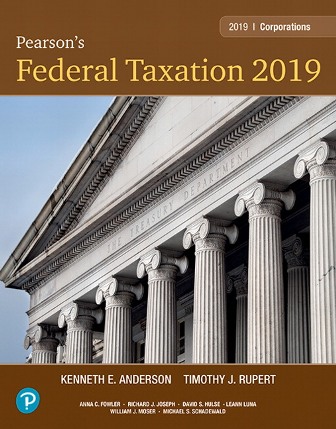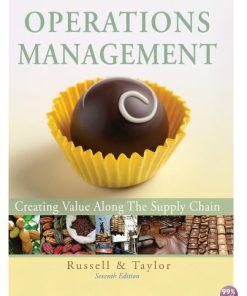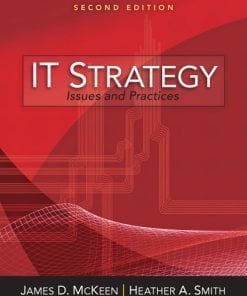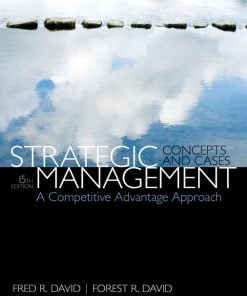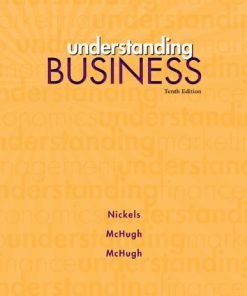Solution Manual for Pearson’s Federal Taxation 2019 Corporations, Partnerships, Estates and Trusts, 32nd Edition, Timothy J. Rupert, Kenneth E. Anderson
$35.00 Original price was: $35.00.$26.50Current price is: $26.50.
Solution Manual for Pearson’s Federal Taxation 2019 Corporations, Partnerships, Estates and Trusts, 32nd Edition, Timothy J. Rupert, Kenneth E. Anderson,
This is completed downloadable of Solution Manual for Pearson’s Federal Taxation 2019 Corporations, Partnerships, Estates and Trusts, 32nd Edition, Timothy J. Rupert, Kenneth E. Anderson
Product Details:
- ISBN-10 : 0134739698
- ISBN-13 : 978-0134739694
- Author: Timothy J. Rupert, Kenneth E. Anderson
The Rupert/Anderson series is unsurpassed in blending technical aspects of the most recent federal taxation mandates with maximum readability and relevance for students. Containing strong pedagogical tools that enable readers to apply tax principles within the text to real-life situations, and tax information from 2017 and early 2018,Pearson’s Federal Taxation 2019 Corporations, Partnerships, Estates & Trusts, 32nd Edition provides an up-to-date resource and better teaching and learning experience — for instructors and students.
Table of Content:
- Instructor Teaching Resources
- Chapter 1 Tax Research
- Learning Objectives
- Chapter Outline
- Overview of Tax Research
- Objective 1
- Steps in the Tax Research Process
- Objective 2
- Importance of the Facts to the Tax Consequences
- Objective 3
- Creating a Factual Situation Favorable to the Taxpayer
- The Sources of Tax Law
- Objective 4
- The Legislative Process
- The Internal Revenue Code
- Treasury Regulations
- Proposed, Temporary, and Final Regulations
- Interpretative and Legislative Regulations
- Authoritative Weight
- Citations
- Administrative Pronouncements
- Revenue Rulings
- Revenue Procedures
- Letter Rulings
- Other Interpretations
- Technical Advice Memoranda
- News Releases
- Announcements and Notices
- Judicial Decisions
- Overview of the Court System
- The U.S. Tax Court
- Small Cases Procedure
- Acquiescence Policy
- Published Opinions and Citations
- U.S. District Courts
- U.S. Court of Federal Claims
- Circuit Courts of Appeals
- U.S. Supreme Court
- Precedential Value of Various Decisions
- Tax Court
- U.S. District Court
- U.S. Court of Federal Claims
- Circuit Courts of Appeals
- Forum Shopping
- Dictum
- Tax Treaties
- Tax Periodicals
- Tax Services
- Objective 5
- The Internet as a Research Tool
- Objective 6
- Keyword Searches
- Search by Citation
- Noncommercial Internet Services
- Citators
- Objective 7
- Using the Citator
- Professional Guidelines for Tax Services
- Objective 8
- Treasury Department Circular 230
- AICPA’s Statements on Tax Standards
- Sample Work Papers and Client Letter
- Objective 9
- Problem Materials
- Discussion Questions
- Problems
- Comprehensive Problem
- Tax Strategy Problem
- Case Study Problem
- Tax Research Problems
- Chapter 2 Corporate Formations and Capital Structure
- Learning Objectives
- Chapter Outline
- Organization Forms Available
- Objective 1
- Sole Proprietorships
- Tax Advantages
- Tax Disadvantages
- Partnerships
- Tax Advantages
- Tax Disadvantages
- Corporations
- C Corporations
- Tax Advantages
- Tax Disadvantages
- S Corporations
- Tax Advantages
- Tax Disadvantages
- Limited Liability Companies
- Limited Liability Partnerships
- Check-the-Box Regulations
- Objective 2
- Legal Requirements and Tax Considerations Related to Forming a Corporation
- Objective 3
- Legal Requirements
- Tax Considerations
- Section 351: Deferring Gain or Loss Upon Incorporation
- Objective 4
- The Property Requirement
- The Control Requirement
- Transferors of Both Property and Services
- Transfers to Existing Corporations
- Disproportionate Exchanges of Property and Stock
- Immediately After the Exchange
- The Stock Requirement
- Effect of Sec. 351 on the Transferors
- Receipt of Boot
- Computing Gain When Several Assets Are Transferred
- Computing a Shareholder’s Basis
- Boot Property
- Stock
- Transferor’s Holding Period
- Tax Consequences to Transferee Corporation
- Gain or Loss Recognized by the Transferee Corporation
- Transferee Corporation’s Basis for Property Received
- Reduction for Loss Property
- Assumption of the Transferor’s Liabilities
- General Rule—Sec. 357(a)
- Tax Avoidance or No Bona Fide Business Purpose—Sec. 357(b)
- Liabilities in Excess of Basis—Sec. 357(c)
- Liabilities of a Cash Method Taxpayer—Sec. 357(c)(3)
- Other Considerations in a Sec. 351 Exchange
- Recapture of Depreciation
- Computing Depreciation
- Assignment of Income Doctrine
- Choice of Capital Structure
- Objective 5
- Characterization of Obligations as Debt or Equity
- Debt Capital
- Issuance of Debt
- Payment of Interest
- Extinguishment of Debt
- Equity Capital
- Capital Contributions by Shareholders
- Capital Contributions by Nonshareholders
- Worthlessness of Stock or Debt Obligations
- Objective 6
- Securities
- Unsecured Debt Obligations
- Tax Planning Considerations
- Objective 7
- Avoiding Sec. 351
- Avoiding Nonrecognition of Losses Under Sec. 351
- Avoiding Nonrecognition of Gain Under Sec. 351
- Compliance and Procedural Considerations
- Objective 8
- Reporting Requirements Under Sec. 351
- Problem Materials
- Discussion Questions
- Issue Identification Questions
- Problems
- Comprehensive Problems
- Tax Strategy Problems
- Case Study Problems
- Tax Research Problems
- Chapter 3 The Corporate Income Tax
- Learning Objectives
- Chapter Outline
- Corporate Elections
- Objective 1
- Choosing a Calendar or Fiscal Year
- Short Tax Period
- Restrictions on Adopting a Tax Year
- Changing the Annual Accounting Period
- Accounting Methods
- Accrual Method
- Cash Method
- Hybrid Method
- Determining a Corporation’s Taxable Income and Tax Liability
- Objective 2
- Corporate Tax Rate
- Sales and Exchanges of Property
- Capital Gains and Losses
- Net Capital Gain
- Net Capital Losses
- Sec. 291: Tax Benefit Recapture Rule
- Business Expenses
- Organizational Expenditures
- Start-Up Expenditures
- Limitation on Deductions for Accrued Compensation
- Limitation on Net Business Interest
- Entertainment Expenses
- Executive Compensation
- Charitable Contributions
- Timing of the Deduction
- Deducting Contributions of Nonmonetary Property
- Substantiation Requirements
- Maximum Deduction Permitted
- Special Deductions
- Dividends-Received Deduction
- General Rule for Dividends-Received Deduction
- Limitation on Dividends-Received Deduction
- Exception to the Limitation
- Members of an Affiliated Group
- Dividends Received from Foreign Corporations
- Stock Held 45 Days or Less
- Debt-Financed Stock
- Net Operating Losses (NOLs)
- Sequencing the Deduction Calculations
- Exceptions for Closely Held Corporations
- Transactions Between a Corporation and Its Shareholders
- Gains on Sale or Exchange Transactions
- Losses on Sale or Exchange Transactions
- Corporation and Controlling Shareholder Using Different Accounting Methods
- Loss Limitation Rules
- At-Risk Rules
- Passive Activity Limitation Rules
- Controlled Groups of Corporations
- Objective 3
- What is a Controlled Group?
- Parent-Subsidiary Controlled Groups
- Brother-Sister Controlled Groups
- Combined Controlled Groups
- Application of the Controlled Group Test
- Special Rules Applying to Controlled Groups
- Consolidated Tax Returns
- Who Can File a Consolidated Return
- Advantages of Filing a Consolidated Return
- Disadvantages of Filing a Consolidated Return
- Tax Planning Considerations
- Objective 4
- Compensation Planning for Shareholder-Employees
- Advantage of Salary Payments
- Advantage of Fringe Benefits
- Compliance and Procedural Considerations
- Objective 5
- Estimated Taxes
- Estimated Tax Payment Dates
- Penalties for Underpayment of Estimated Tax
- Special Computation Methods
- The Annualized Income Method
- Adjusted Seasonal Income Method
- Reporting the Underpayment
- Paying the Remaining Tax Liability
- Requirements for Filing and Paying Taxes
- When the Return Must be Filed
- Tax Return Schedules
- Schedule L (of Form 1120): The Balance Sheet
- Reconciliation Schedules
- Book-Tax Differences
- Schedule M-1 (of Form 1120)
- Schedule M-3 (of Form 1120)
- Schedule M-2 (of Form 1120)
- Financial Statement Implications
- Objective 6
- Scope, Objectives, and Principles of ASC 740
- Temporary Differences
- Deferred Tax Assets and the Valuation Allowance
- Accounting for Uncertain Tax Positions
- Balance Sheet Classification
- Tax Provision Process
- Comprehensive Example – Year 1
- Comprehensive Example – Year 2
- Other Transactions
- Problem Materials
- Discussion Questions
- Issue Identification Questions
- Problems
- Comprehensive Problem
- Tax Strategy Problem
- Tax Form/Return Preparation Problems
- Case Study Problems
- Tax Research Problems
- Chapter 4 Corporate Nonliquidating Distributions
- Learning Objectives
- Chapter Outline
- Nonliquidating Distributions in General
- Objective 1
- Earnings and Profits (E&P)
- Objective 2
- Current Earnings and Profits
- Computing Current E&P
- Income Excluded from Taxable Income but Included in E&P
- Income Deferred to a Later Year When Computing Taxable Income but Included in E&P in the Current Year
- Income and Deduction Items That Must Be Recomputed for E&P Purposes
- Deductions Allowed for Taxable Income Purposes but Denied for E&P Purposes
- Expenses and Losses Denied for Taxable Income Purposes but Allowed for E&P Purposes
- Distinction Between Current and Accumulated E&P
- Nonliquidating Property Distributions
- Objective 3
- Consequences of Nonliquidating Property Distributions to the Shareholders
- Consequences of Property Distributions to The Distributing Corporation
- Corporate Gain or Loss on Property Distributions
- Effect of Property Distributions on the Distributing Corporation’s E&P
- Constructive Dividends
- Intentional Efforts to Avoid Dividend Treatment
- Unintentional Constructive Dividends
- Loans to Shareholders
- Excessive Compensation Paid to Shareholder-Employees
- Insufficient Salary Amounts
- Excessive Compensation Paid to Shareholders for the Use of Shareholder Property
- Corporate Payments for the Shareholder’s Benefit
- Bargain Purchase of Corporate Property
- Shareholder Use of Corporate Property
- Stock Dividends and Stock Rights
- Objective 4
- Nontaxable Stock Dividends
- Nontaxable Stock Rights
- Effect of Nontaxable Stock Dividends on the Distributing Corporation
- Taxable Stock Dividends and Stock Rights
- Stock Redemptions
- Objective 5
- Tax Consequences of the Redemption to the Shareholder
- Attribution Rules
- Family Attribution
- Attribution from Entities
- Attribution to Entities
- Option Attribution
- Substantially Disproportionate Redemptions
- Complete Termination of the Shareholder’s Interest
- Redemptions not Essentially Equivalent to a Dividend
- Partial Liquidations
- Determination Made at the Corporate Level
- Safe Harbor Rule
- Tax Consequences of a Partial Liquidation to the Shareholders
- Redemptions to Pay Death Taxes
- Effect of Redemptions on the Distributing Corporation
- Corporate Gain or Loss on Property Distributions
- Effect of Redemptions on E&P
- Preferred Stock Bailouts
- Objective 6
- Sec. 306 Stock Defined
- Dispositions of Sec. 306 Stock
- Redemptions of Sec. 306 Stock
- Exceptions to Sec. 306 Treatment
- Stock Redemptions by Related Corporations
- Objective 7
- Brother-Sister Corporations
- Redemption Treated as a Distribution
- Redemption Treated as a Sale
- Parent-Subsidiary Corporations
- Redemption Treated as a Dividend
- Redemption Treated as a Sale
- Tax Planning Considerations
- Objective 8
- Avoiding Unreasonable Compensation
- Bootstrap Acquisitions
- Timing of Distributions
- Compliance and Procedural Considerations
- Objective 9
- Corporate Reporting of Nondividend Distributions
- Agreement to Terminate Interest Under Sec. 302(b)(3)
- Problem Materials
- Discussion Questions
- Issue Identification Questions
- Problems
- Comprehensive Problem
- Tax Strategy Problem
- Case Study Problems
- Tax Research Problems
- Chapter 5 Other Corporate Tax Levies
- Learning Objectives
- Chapter Outline
- Use of C Corporation to Avoid Income Taxes
- Objective 1
- Personal Holding Company Tax
- Objective 2
- Personal Holding Company Defined
- Stock Ownership Requirement
- Passive Income Requirement
- Adjusted Ordinary Gross Income Defined
- Reduction by Rental Income Expenses
- Personal Holding Company Income Defined
- Exclusion for Rents
- Exclusion for Personal Service Contracts
- Calculating the PHC Tax
- Calculating UPHCI
- Positive Adjustments to Taxable Income
- Negative Adjustments to Taxable Income
- Avoiding the PHC Designation and Tax Liability by Making Dividend Distributions
- PHC Tax Calculation
- Accumulated Earnings Tax
- Objective 3
- Corporations Subject to The Penalty Tax
- Proving a Tax-Avoidance Purpose
- Evidence Concerning the Reasonableness of an Earnings Accumulation
- Evidence of a Tax-Avoidance Purpose
- Reasonable Needs of the Business
- Reasonably Anticipated Needs of the Business
- Need for Accumulation
- Specific, Definite, and Feasible Plans
- No Specific Time Limitations
- Impact of Subsequent Events
- Working Capital: The Bardahl Formula
- Calculating the Accumulated Earnings Tax
- Accumulated Taxable Income
- Positive Adjustments to Regular Taxable Income
- Negative Adjustments to Taxable Income
- Dividends-Paid Deduction
- Accumulated Earnings Credit
- Comprehensive Example
- Tax Planning Considerations
- Objective 4
- Avoiding the Personal Holding Company Tax
- Changes in the Corporation’s Stock Ownership
- Changing the Amount and Type of Income Earned by the Corporation
- Dividend Distributions
- Making an S Corporation Election
- Liquidating the Corporation
- Avoiding the Accumulated Earnings Tax
- Compliance and Procedural Considerations
- Objective 5
- Personal Holding Company Tax
- Filing Requirements for Tax Returns
- Payment of the Tax, Interest, and Penalties
- Accumulated Earnings Tax
- Problem Materials
- Discussion Questions
- Issue Identification Questions
- Problems
- Comprehensive Problem
- Tax Strategy Problems
- Case Study Problems
- Tax Research Problems
- Chapter 6 Corporate Liquidating Distributions
- Learning Objectives
- Chapter Outline
- Overview of Corporate Liquidations
- Objective 1
- The Shareholder
- The Corporation
- Definition of a Complete Liquidation
- General Liquidation Rules
- Objective 2
- Effects of Liquidating on the Shareholders
- Amount of Recognized Gain or Loss
- Impact of Accounting Method
- When Stock Is Acquired
- Character of the Recognized Gain or Loss
- Basis and Holding Period of Property Received in the Liquidation
- Effects of Liquidating on the Liquidating Corporation
- Recognition of Gain or Loss When Corporation Distributes Property in Redemption of Stock
- Liabilities Assumed or Acquired by the Shareholders
- Exceptions to the General Gain or Loss Recognition Rule
- Distributions to Related Persons
- Sales Having a Tax-Avoidance Purpose
- Liquidation of a Controlled Subsidiary
- Objective 3
- Overview
- Requirements
- Stock Ownership
- Cancellation of the Stock
- Timing of the Distributions
- Effects of Liquidating on the Shareholders
- Recognition of Gain or Loss to Parent Corporation
- Treatment of Minority Shareholders
- Basis of Property Received
- Effects of Liquidating on the Subsidiary Corporation
- Recognition of Gain or Loss
- Tax Attribute Carryovers
- Special Reporting Issues
- Objective 4
- Pertaining to Shareholders
- Partially Liquidating Distributions
- Subsequent Assessments
- Open Versus Closed Transactions
- Installment Obligations
- Pertaining to the Liquidating Corporation
- Expenses of the Liquidation
- Treatment of Net Operating Losses
- Recognition of Gain or Loss When Property is Distributed in Retirement of Debt
- Objective 5
- General Rule
- Satisfaction of the Subsidiary’s Debt Obligations
- Tax Planning Considerations
- Objective 6
- Timing the Liquidation Transaction
- Recognition of Ordinary Losses when a Liquidation Occurs
- Obtaining 80% Ownership to Achieve Sec. 332 Benefits
- Avoiding Sec. 332 to Recognize Losses
- Compliance and Procedural Considerations
- Objective 7
- General Liquidation Procedures
- Section 332 Liquidations
- Plan of Liquidation
- Problem Materials
- Discussion Questions
- Issue Identification Questions
- Problems
- Comprehensive Problem
- Tax Strategy Problems
- Case Study Problems
- Tax Research Problems
- Chapter 7 Corporate Acquisitions and Reorganizations
- Learning Objectives
- Chapter Outline
- Taxable Acquisition Transactions
- Objective 1
- Asset Acquisitions
- Stock Acquisitions
- Stock Acquisition with No Liquidation
- Stock Acquisition Followed by a Liquidation
- Section 338 Deemed Sale Election
- Eligible Stock Acquisitions
- The Election
- Deemed Sale Transaction
- Tax Basis of the Assets After the Deemed Sale
- Allocation of Basis to Individual Assets
- Section 336(e) Deemed Sale Election
- Comparison of Taxable and Nontaxable Acquisitions
- Objective 2
- Taxable and Nontaxable Asset Acquisitions
- Tax Consequences to the Target Corporation
- Tax Consequences to the Acquiring Corporation
- Tax Consequences to the Target Corporation Shareholders
- Accounting for the Acquisition
- Comparison of Taxable and Nontaxable Stock Acquisitions
- Tax Consequences to the Target Corporation
- Tax Consequences to the Acquiring Corporation
- Tax Consequences to the Target Corporation Shareholders
- Types of Reorganizations and Their Tax Consequences
- Objective 3
- The Target or Transferor Corporation
- Recognition of Gain or Loss on Asset Transfer
- Depreciation Recapture
- Assumption of Liabilities
- Recognition of Gain or Loss on Distribution of Stock and Securities
- The Acquiring or Transferee Corporation
- Amount of Gain or Loss Recognized
- Basis of Acquired Property
- Holding Period of Acquired Property
- Shareholders and Security Holders
- Amount of Gain or Loss Recognized
- Character of the Recognized Gain
- Basis of Stock and Securities Received
- Holding Period
- Acquisitive Reorganizations
- Objective 4
- Type a Reorganization
- Merger or Consolidation
- Requirements for Mergers and Consolidations
- Advantages and Disadvantages of a Type A Reorganization
- Tax Consequences of a Merger
- Drop-Down Type A Reorganization
- Triangular Mergers
- The “Substantially All” Requirement
- Advantages of a Triangular Merger
- Reverse Triangular Mergers
- Type C Reorganization
- Consideration Used to Effect the Reorganization
- Advantages and Disadvantages of a Type C Reorganization
- Tax Consequences of a Type C Reorganization
- Drop-Down and Triangular Type C Reorganizations
- Type D Reorganization
- Control Requirements
- Tax Consequences of a Type D Reorganization
- Type B Reorganization
- Solely-for-Voting-Stock Requirement
- Exceptions
- Control
- Timing of the Transaction
- Tax Consequences of a Type B Reorganization
- Advantages of a Type B Reorganization
- Disadvantages of a Type B Reorganization
- Drop-Down and Triangular Type B Reorganizations
- Type G Reorganization
- Divisive Reorganizations
- Objective 5
- Divisive Type D Reorganization
- Forms of Divisive Type D Reorganizations
- Asset Transfer
- Distribution of Stock and Securities
- The Sec. 355 Requirements
- Divisive Type G Reorganization
- Other Reorganizations
- Objective 6
- Type E Reorganization
- Stock-for-Stock Exchange
- Bond-for-Stock Exchange
- Bond-for-Bond Exchange
- Type F Reorganization
- Judicial Restrictions on the Use of Corporate Reorganizations
- Objective 7
- Continuity of Interest
- Continuity of Business Enterprise
- Business Purpose Requirement
- Step Transaction Doctrine
- Tax Attributes
- Objective 8
- Assumption of Tax Attributes
- Limitation on Use of Tax Attributes
- Section 382
- Stock Ownership Change
- Loss Limitation
- Section 383
- Section 384
- Section 269
- Tax Planning Considerations
- Objective 9
- Why Use a Reorganization Instead of a Taxable Transaction?
- Avoiding the Reorganization Provisions
- Compliance and Procedural Considerations
- Objective 10
- Section 338 Election
- Plan of Reorganization
- Party to a Reorganization
- Ruling Requests
- Financial Statement Implications
- Objective 11
- Taxable Asset Acquisition
- Nontaxable Asset Acquisition
- Stock Acquisition
- Pricing The Acquisition
- Net Operating Losses
- Problem Materials
- Discussion Questions
- Issue Identification Questions
- Problems
- Comprehensive Problem
- Tax Strategy Problems
- Case Study Problems
- Tax Research Problems
- Chapter 8 Consolidated Tax Returns
- Learning Objectives
- Chapter Outline
- Definition of an Affiliated Group
- Objective 1
- Requirements
- Stock Ownership Requirements
- Includible Corporation Requirement
- Comparison with Controlled Group Definitions
- Consolidated Tax Return Election
- Objective 2
- Consolidated Return Regulations
- Terminology
- Termination of Consolidated Tax Return Filing
- Termination of the Affiliated Group
- Good Cause Request to Discontinue Consolidation
- Effects on Former Members
- Consolidated Taxable Income
- Objective 3
- Accounting Periods and Methods
- Accounting Periods
- Accounting Methods
- Income Included in the Consolidated Tax Return
- Calculation of Consolidated Taxable Income and Tax
- Intercompany Transactions
- Objective 4
- Basic Concepts
- Matching and Acceleration Rules
- Matching Rule
- Acceleration Rule
- Applications of Matching and Acceleration Rules
- Installment Sale of Property from Buyer to Third Party
- Performance of Services
- Intercompany Sale of Inventory
- Relevance of Matching and Acceleration Rules
- Items Computed on a Consolidated Basis
- Objective 5
- Charitable Contribution Deduction
- Net Sec. 1231 Gain or Loss
- Capital Gains and Losses
- Departing Group Members’ Capital Losses
- SRLY Limitation
- Dividends-Received Deduction
- Dividends Received from Non-Group Members
- Dividends Received from Group Members
- Regular Tax Liability
- Tax Credits
- General Business Credit
- Foreign Tax Credit
- Estimated Tax Payments
- Large Corporation Rule
- Consolidated or Separate Basis
- Short-Period Return
- Net Operating Losses (NOLs)
- Objective 6
- Current Year NOL
- Carryovers of Consolidated NOLs
- General Rule
- Special Loss Limitations
- Separate Return Limitation Year Rules
- Consolidated Sec. 382 Rules
- SRLY-Sec. 382 Overlap
- Stock Basis Adjustments
- Objective 7
- Tiering up of Stock Basis Adjustments
- Excess Loss Account
- Tax Planning Considerations
- Objective 8
- Advantages of Filing a Consolidated Tax Return
- Disadvantages of Filing a Consolidated Tax Return
- Compliance and Procedural Considerations
- Objective 9
- The Basic Election and Return
- Parent Corporation as Agent for the Consolidated Group
- Separate Entity Treatment of Intercompany Transactions
- Liability for Taxes Due
- Financial Statement Implications
- Objective 10
- Intercompany Transactions
- SRLY Losses
- Problem Materials
- Discussion Questions
- Issue Identification Questions
- Problems
- Comprehensive Problems
- Tax Strategy Problem
- Tax Form/Return Preparation Problem
- Case Study Problem
- Tax Research Problems
- Chapter 9 Partnership Formation and Operation
- Learning Objectives
- Chapter Outline
- Definition of a Partnership
- Objective 1
- General and Limited Partnerships
- General Partnerships
- Limited Partnerships
- Limited Liability Limited Partnerships (LLLPs)
- Limited Liability Companies (LLCs)
- Limited Liability Partnerships (LLPs)
- Overview of Taxation of Partnership Income
- Objective 2
- Partnership Profits and Losses
- The Partner’s Basis
- Partnership Distributions
- Tax Implications of Formation of a Partnership
- Objective 3
- Contribution of Property
- Nonrecognition of Gain or Loss
- Recognition of Gain or Loss
- Effects of Liabilities
- Partner’s Basis in the Partnership Interest (Commonly Called Outside Basis)
- Holding Period for Partnership Interest
- Partnership’s Basis in Property
- Unrealized Receivables
- Inventory
- Capital Loss Property
- Partnership’s Holding Period
- Section 1245 and 1250 Property Rules
- Contribution of Property After Formation
- Contribution of Services
- Consequences to the Partnership
- Allocating the Expense Deduction
- Partnership Gain or Loss
- Organizational and Syndication Expenditures
- Partnership Elections
- Objective 4
- Partnership Tax Year
- Section 706 Restrictions
- Other Partnership Elections
- Partnership Reporting of Income
- Objective 5
- Partnership Taxable Income
- Separately Stated Items
- Partnership Ordinary Income
- Special Deductions and Limitations
- Qualified Business Income Deduction
- Limitation on Net Business Interest
- Partner Reporting of Income
- Objective 6
- Partner’s Distributive Share
- Partnership Agreement
- Varying Interest Rule
- Special Allocations
- Allocations Related to Contributed Property
- Substantial Economic Effect
- Basis for Partnership Interest
- Objective 7
- Beginning Basis
- Effects of Liabilities
- Increases and Decreases in Liabilities
- A Partner’s Share of Liabilities
- Recourse and Nonrecourse Loans
- General and Limited Partners
- Effects of Operations
- Loss Limitation Pertaining to Outside Basis
- Special Loss Limitations
- Objective 8
- At-Risk Loss Limitation
- Passive Activity Limitations
- Limitation on Excess Business Losses
- Transactions Between a Partner and the Partnership
- Objective 9
- Sales of Property
- Loss Sales
- Gain Sales
- Guaranteed Payments
- Determining the Guaranteed Payment
- Tax Impact of Guaranteed Payments
- Family Partnerships
- Objective 10
- Capital Ownership
- Donor Retained Control
- Minor Donees
- Donor-Donee Allocations of Income
- Tax Planning Considerations
- Objective 11
- Timing of Loss Recognition
- Guaranteed Payments
- Compliance and Procedural Considerations
- Objective 12
- Reporting to the IRS and the Partners
- Forms
- Schedule M-3
- Section 444 Election and Required Payments
- Estimated Taxes
- Self-Employment Income
- IRS Audit Procedures
- Problem Materials
- Discussion Questions
- Issue Identification Questions
- Problems
- Comprehensive Problems
- Tax Strategy Problem
- Tax Form/Return Preparation Problems
- Case Study Problems
- Tax Research Problems
- Chapter 10 Special Partnership Issues
- Learning Objectives
- Chapter Outline
- Nonliquidating Distributions
- Objective 1
- Recognition of Gain
- Basis Effects of Distributions
- Holding Period and Character of Distributed Property
- Nonliquidating Distributions with Sec. 751
- Objective 2
- Section 751 Assets Defined
- Unrealized Receivables
- Inventory
- Exchange of Sec. 751 Assets and Other Property
- Liquidating or Selling a Partnership Interest
- Objective 3
- Liquidating Distributions
- Gain or Loss Recognition by the Partner
- Basis in Assets Received
- Holding Period in Distributed Assets
- Effects of Sec. 751
- Effects of Distribution on the Partnership
- Sale of a Partnership Interest
- Section 751 Property
- Liabilities
- Impact on the Partnership
- Other Partnership Termination Issues
- Objective 4
- Retirement or Death of a Partner
- Payments for Partnership Property
- Other Payments
- Exchange of a Partnership interest
- Exchange for Another Partnership Interest
- Exchange for Corporate Stock
- Incorporation
- Formation of an LLC, LLP, or LLLP
- Income Recognition and Transfers of a Partnership Interest
- Termination of a Partnership
- Events Causing a Termination to Occur
- No Business Operated as a Partnership
- Effects of Termination
- Importance of Timing
- Liquidating Distributions and Contributions
- Mergers and Consolidations
- Division of a Partnership
- Optional and Mandatory Basis Adjustments
- Objective 5
- Adjustments on Transfers
- Optional Adjustment
- Amount of the Adjustment
- Mandatory Adjustment
- Other Issues
- Adjustments on Distributions
- Optional Adjustment
- Mandatory Adjustment
- Special Forms of Partnerships
- Objective 6
- Tax Shelters and Limited Partnerships
- Publicly Traded Partnerships
- Limited Liability Companies
- Limited Liability Partnerships
- Limited Liability Limited Partnership
- Tax Planning Considerations
- Objective 7
- Liquidating Distribution or Sale to Partners
- Problem Materials
- Discussion Questions
- Issue Identification Questions
- Problems
- Comprehensive Problems
- Tax Strategy Problem
- Case Study Problem
- Tax Research Problems
- Chapter 11 S Corporations
- Learning Objectives
- Chapter Outline
- Should an S Election Be Made?
- Objective 1
- Advantages of S Corporation Treatment
- Disadvantages of S Corporation Treatment
- S Corporation Requirements
- Objective 2
- Shareholder-Related Requirements
- 100-Shareholder Rule
- Eligible Shareholders
- Alien Individuals
- Corporation-Related Requirements
- General Rules
- Debt Instruments
- Election of S Corporation Status
- Objective 3
- Making the Election
- Consent of Shareholders
- Termination of the Election
- Revocation of the Election
- Termination of the Election
- Allocation of Income
- Inadvertent Termination
- Other IRS Waivers
- New Election Following a Termination
- Avoiding Termination of an S Election
- S Corporation Operations
- Objective 4
- Taxable Year
- Accounting Method Elections
- Ordinary Income or Loss and Separately Stated Items
- Deductions That Cannot Be Claimed
- Similarity to C Corporation Treatment
- Carryovers When Status Changes
- Special S Corporation Taxes
- Excess Net Passive Income Tax
- Built-in Gains Tax
- LIFO Recapture Tax
- Taxation of the Shareholder
- Objective 5
- Income Allocation Procedures
- Income Pass-Though To Shareholders
- Loss and Deduction Pass-Through to Shareholders
- Allocation of the Loss
- Shareholder Loss Limitations
- Special Shareholder Loss and Deduction Limitations
- Post-Termination Loss Carryovers
- Family S Corporations
- Basis Adjustments
- Objective 6
- Basis Adjustments to S Corporation Stock
- Basis Adjustments to Shareholder Debt
- S Corporation Distributions
- Objective 7
- Corporations Having No Earnings and Profits
- Corporations Having Accumulated Earnings and Profits
- Prior Rules
- Current Rules
- Money Distributions
- Property Distributions
- Distribution Ordering Elections
- Post-Termination Transition Period
- Other Rules
- Objective 8
- Tax Preference Items and Other AMT Adjustments
- Transactions Involving Shareholders and Other Related Parties
- Fringe Benefits Paid to a Shareholder-Employee
- Tax Planning Considerations
- Objective 9
- Election to Allocate Income Based on the S Corporation’s Accounting Methods
- Increasing the Benefits from S Corporation Losses
- Salary Levels
- Passive Income Requirements
- Compliance and Procedural Considerations
- Objective 10
- Making the Election
- Filing the Corporate Tax Return
- Estimated Tax Payments
- Consistency Rules
- Sample S Corporation Tax Return
- Problem Materials
- Discussion Questions
- Issue Identification Questions
- Problems
- Comprehensive Problems
- Tax Strategy Problems
- Tax Form/Return Preparation Problems
- Case Study Problem
- Tax Research Problems
- Chapter 12 The Gift Tax
- Learning Objectives
- Chapter Outline
- The Unified Transfer Tax System
- Objective 1
- History and Purpose of Transfer Taxes
- Unified Rate Schedule
- Impact of Taxable Gifts on Death Tax Base
- Unified Credit
- Gift Tax Formula
- Objective 2
- Determination of Gifts
- Exclusions and Deductions
- Gift-Splitting Election
- Cumulative Nature of Gift Tax
- Unified Credit
- Transfers Subject to the Gift Tax
- Objective 3
- Transfers for Inadequate Consideration
- Bargain Sales
- Transfers in Normal Course of Business
- Statutory Exemptions from the Gift Tax
- Payment of Medical Expenses or Tuition
- Transfers to Political Organizations
- Property Settlements in Conjunction with Divorce
- Qualified Disclaimers
- Cessation of Donor’s Dominion and Control
- Revocable Trusts
- Other Retained Powers
- Valuation of Gifts
- General Rules
- Life Estates and Remainder Interests
- Special Valuation Rules: Estate Freezes
- Gift Tax Consequences of Certain Transfers
- Creation of Joint Bank Accounts
- Creation of Other Joint Tenancies
- Transfer of Life Insurance Policies
- Exercise of a General Power of Appointment
- Net Gifts
- Exclusions
- Objective 4
- Amount of the Exclusion
- Present Interest Requirement
- Definition of Present Interest
- Definition of Future Interest
- Special Rule for Trusts for Minors
- Crummey Trust
- Gift Tax Deductions
- Objective 5
- Marital Deduction
- Unlimited Amount
- Gifts of Terminable Interests: General Rule
- Nondeductible Terminable Interests
- QTIP Provisions
- Charitable Contribution Deduction
- Transfers Eligible for the Deduction
- Split-Interest Transfers
- The Gift-Splitting Election
- Objective 6
- Computation of the Gift Tax Liability
- Objective 7
- Effect of Previous Taxable Gifts
- Unified Credit Available
- Comprehensive Illustration
- Background Data
- Calculation of Tax Liability
- Basis Considerations for a Lifetime Giving Plan
- Objective 8
- Property Received by Gift
- Property Received at Death
- Below-Market Loans: Gift and Income Tax Consequences
- Objective 9
- General Rules
- De Minimis Rules
- Tax Planning Considerations
- Objective 10
- Tax-Saving Features of Inter Vivos Gifts
- Use of Annual Exclusion
- Removal of Post-Gift Appreciation from Tax Base
- Removal of Gift Tax Amount from Transfer Tax Base
- Income Shifting
- Gift in Contemplation of Donee-Spouse’s Death
- Lessening State Transfer Tax Costs
- Income Tax Savings from Charitable Gifts
- Negative Aspects of Gifts
- Loss of Step-Up in Basis
- Prepayment of Estate Tax
- Compliance and Procedural Considerations
- Objective 11
- Filing Requirements
- Due Date
- Gift-Splitting Election
- Liability for Tax
- Determination of Value
- Penalty for Undervaluation
- Statute of Limitations
- Problem Materials
- Discussion Questions
- Issue Identification Questions
- Problems
- Comprehensive Problem
- Tax Strategy Problems
- Tax Form/Return Preparation Problems
- Case Study Problems
- Tax Research Problems
- Chapter 13 The Estate Tax
- Learning Objectives
- Chapter Outline
- Estate Tax Formula
- Objective 1
- Gross Estate
- Deductions
- Adjusted Taxable Gifts and Tax Base
- Tentative Tax on Estate Tax Base
- Reduction for Post-1976 Gift Taxes
- Unified Credit
- The Gross Estate: Valuation
- Objective 2
- Date-of-Death Valuation
- Listed Stocks
- Interests in Firms Whose Stock Is Not Publicly Traded
- Real Estate
- Annuities, Interests for Life or a Term of Years, Reversions, Remainders
- Alternate Valuation Date
- The Gross Estate: Inclusions
- Objective 3
- Comparison of Gross Estate With Probate Estate
- Property in Which the Decedent had an Interest
- Dower or Curtesy Rights
- Transferor Provisions
- Gifts Made Within Three Years of Death
- Gross-Up Rule
- Transfers with Retained Life Estate
- Reversionary Interests
- Revocable Transfers
- Annuities and Other Retirement Benefits
- Annuities Not Related to Employment
- Employment-Related Retirement Benefits
- Jointly Owned Property
- Ownership Involving Persons Other than Spouses
- Ownership Involving Only Spouses
- General Powers of Appointment
- Life Insurance
- Consideration Offset
- Recipient Spouse’s Interest in QTIP Trust
- Deductions
- Objective 4
- Debts and Funeral and Administration Expenses
- Losses
- Charitable Contribution Deduction
- Computing the Deduction
- Split-Interest Transfers
- Marital Deduction
- Test 1: Inclusion in the Gross Estate
- Test 2: The Passing Requirement
- Test 3: The Terminable Interest Rule
- QTIP Transfers
- State Death Taxes
- Computation of Tax Liability
- Objective 5
- Taxable Estate and Tax Base
- Tentative Tax and Reduction for Post-1976 Gift Taxes
- Unified Credit
- Portability Between Spouses of Exemption Amount
- Other Credits
- Pre-2005 State Death Tax Credit
- Credit for Pre-1977 Gift Taxes
- Credit for Tax on Prior Transfers
- Foreign Death Tax Credit
- Comprehensive Illustration
- Background Data
- Calculation of Tax Liability
- Liquidity Concerns
- Objective 6
- Deferral of Payment of Estate Taxes
- Reasonable Cause
- Remainder or Reversionary Interests
- Interests in Closely Held Businesses
- Stock Redemptions to Pay Death Taxes
- Special Use Valuation of Farm Real Property
- Generation-Skipping Transfer Tax
- Objective 7
- Tax Planning Considerations
- Objective 8
- Use of Inter Vivos Gifts
- Use of Basic Exclusion Amount
- What Size Marital Deduction Is Best?
- Use of Disclaimers
- Role of Life Insurance
- Qualifying the Estate for Installment Payments
- Where to Deduct Administration Expenses
- Compliance and Procedural Considerations
- Objective 9
- Filing Requirements
- Due Date
- Valuation
- Election of Alternate Valuation Date
- Problem Materials
- Discussion Questions
- Issue Identification Questions
- Problems
- Comprehensive Problems
- Tax Strategy Problems
- Tax Form/Return Preparation Problems
- Case Study Problems
- Tax Research Problems
- Chapter 14 Income Taxation of Trusts and Estates
- Learning Objectives
- Chapter Outline
- Basic Concepts
- Objective 1
- Inception of Trusts
- Inception of Estates
- Reasons for Creating Trusts
- Tax Saving Aspects of Trusts
- Nontax Aspects of Trusts
- Basic Principles of Fiduciary Taxation
- Trusts and Estates as Separate Taxpayers
- No Double Taxation
- Conduit Approach
- Similarity to Rules for Individuals
- Principles of Fiduciary Accounting
- Objective 2
- The Importance of Identifying Income and Principal
- Principal and Income: The Uniform Act
- Income Receipts
- Principal Receipts
- Expenditures
- Categorization of Depreciation
- Formula for Taxable Income and Tax Liability
- Objective 3
- Gross Income
- Deductions for Expenses
- Distribution Deduction
- Simple Trusts.
- Complex Trusts
- Personal Exemption
- Credits
- Distributable Net Income
- Objective 4
- Significance of DNI
- Definition of DNI
- Manner of Computing DNI
- Determining a Simple Trust’s Taxable Income
- Objective 5
- Allocation of Expenses to Tax-Exempt Income
- Determination of DNI and the Distribution Deduction
- Tax Treatment for Beneficiary
- Shortcut Approach to Proving Correctness of Taxable Income
- Effect of a Net Operating Loss
- Effect of a Net Capital Loss
- Comprehensive Illustration: Determining a Simple Trust’s Taxable Income
- Background Data
- Trustee’s Fee
- Distribution Deduction and DNI
- Trust’s Taxable Income and Tax
- Categorizing a Beneficiary’s Income
- Determining Taxable Income for Complex Trusts and Estates
- Objective 6
- Determination of DNI and the Distribution Deduction
- Tax Treatment for Beneficiary
- General Rules
- Exception—The Tier System
- Exception—Separate Share Rule
- Exception—Specific Bequests
- Effect of a Net Operating Loss
- Effect of a Net Capital Loss
- Comprehensive Illustration: Determining a Complex Trust’s Taxable Income
- Background Data
- Trustee’s Fee
- Distribution Deduction and DNI
- Trust’s Taxable Income
- Additional Observations
- Income in Respect of a Decedent
- Objective 7
- Definition and Common Examples
- Significance of IRD
- Double Taxation
- Deductions in Respect of a Decedent
- Section 691(c) Deduction
- No Step-Up in Basis
- Grantor Trust Provisions
- Objective 8
- Purpose and Effect
- Revocable Trusts
- Post-1986 Reversionary Interest Trusts
- Retention of Administrative Powers
- Retention of Economic Benefits
- Control of Others’ Enjoyment
- Tax Planning Considerations
- Objective 9
- Ability to Shift Income
- Timing of Distributions
- Property Distributions
- Choice of Year-End for Estates
- Deduction of Administration Expenses
- Compliance and Procedural Considerations
- Objective 10
- Filing Requirements
- General Rule
- Due Date for Return and Tax
- Documents to be Furnished to IRS
- Sample Simple and Complex Trust Returns
- Problem Materials
- Discussion Questions
- Issue Identification Questions
- Problems
- Comprehensive Problem
- Tax Strategy Problems
- Tax Form/Return Preparation Problems
- Case Study Problems
- Tax Research Problems
- Chapter 15 Administrative Procedures
- Learning Objectives
- Chapter Outline
- Role of the Internal Revenue Service
- Objective 1
- Enforcement and Collection
- Interpretation of the Statute
- Audits of Tax Returns
- Objective 2
- Percentage of Returns Examined
- Selection of Returns for Audit
- Other Methods
- Disclosure of Uncertain Tax Positions
- Alternatives for a Taxpayer Whose Return is Audited
- Special Relief Rule
- Meeting with a Revenue Agent
- Technical Advice Memoranda
- Appeal to Appeals Division
- 90-Day Letter
- Litigation
- U.S. Tax Court
- U.S. District Court or U.S. Court of Federal Claims
- Appeal of a Lower Court’s Decision
- Burden of Proof
- Requests for Rulings
- Objective 3
- Information to be Included in Taxpayer’s Request
- Will the IRS Rule?
- When Rulings are Desirable
- Due Dates
- Objective 4
- Due Dates for Returns
- Extensions
- Individuals
- Corporations
- Due Dates for Payment of the Tax
- Interest on Tax not Timely Paid
- Rate Determination
- Daily Compounding
- Accrual Period
- Abatement
- Failure-to-File and Failure-to-Pay Penalties
- Objective 5
- Failure to File
- Failure to Pay
- Estimated Taxes
- Objective 6
- Payment Requirements
- Penalty for Underpaying Estimated Taxes
- Exceptions to the Penalty
- Other More Severe Penalties
- Objective 7
- Negligence
- Substantial Understatement
- Understatement Versus Underpayment
- Concept of Substantial Authority
- Tax Shelters and Reportable Transactions
- Transactions without Economic Substance
- Civil Fraud
- Criminal Fraud
- Criminal Fraud Investigations
- Penalty Provisions
- Section 7201
- Section 7203
- Section 7206
- Statute of Limitations
- Objective 8
- General Three-Year Rule
- Six-Year Rule for Substantial Omissions
- Income Tax Returns
- Gift and Estate Tax Returns
- When no Return is Filed
- Other Exceptions to Three-Year Rule
- Extension of the Three-Year Limitations Period
- NOL Carrybacks
- When Fraud Is Proven
- Deficiency and Civil Fraud Penalty
- Criminal Provisions
- Refund Claims
- Liability for Tax
- Objective 9
- Joint Returns
- Validity of Joint Return
- Innocent Spouse Provision
- Equitable Relief
- The Effect of Community Property Laws
- Transferee Liability
- Tax Practice Issues
- Objective 10
- Statutory Provisions Concerning Tax Return Preparers
- Reportable Transaction Disclosures
- Rules of Circular 230
- Statements on Standards for Tax Services
- Tax Accounting and Tax Law
- Accountant-Client Privilege
- Problem Materials
- Discussion Questions
- Issue Identification Questions
- Problems
- Comprehensive Problem
- Tax Strategy Problem
- Case Study Problem
- Tax Research Problems
- Chapter 16 U.S. Taxation of Foreign-Related Transactions
- Learning Objectives
- Chapter Outline
- The U.S. System of International Taxation
- Objective 1
- Participation Exemption System
- The Lock-Out Effect of Using a Foreign Subsidiary
- Sec. 245A Dividends-Received Deduction
- Stock Basis Reduction
- Taxation of U.S. Citizens and Resident Aliens
- Objective 2
- Foreign Tax Credit
- Creditable Taxes
- Eligibility for the Credit
- Translation of the Foreign Tax Payments
- Foreign Tax Credit Limitation
- Calculating the General Limitation
- Determining the Income Amounts
- Foreign Tax Credit Carrybacks and Carryovers
- Special Foreign Tax Credit Limitations
- Foreign-Earned Income Exclusion
- U.S. Citizens and Resident Aliens Working Abroad
- Bona Fide Residence Test
- Physical Presence Test
- Foreign Earned Income Defined
- Amount of the Exclusion
- Housing Cost Exclusion or Deduction
- Disallowance of Deductions and Credits
- Taxation of Nonresident Aliens
- Objective 3
- Definition of Nonresident Alien
- Investment Income
- Trade or Business Income
- Special Election for Real Estate Investors
- Effectively Connected Tests
- Calculating the Tax
- Taxation of U.S. Businesses Operating Abroad
- Objective 4
- Domestic Subsidiary Corporations
- Foreign Branches
- Foreign Corporations
- Potential Deferral of Tax on Foreign Earnings
- Deferral Privilege
- Exceptions to the Deferral Privilege
- Deemed Repatriation
- Foreign Tax Credit Baskets
- Taxation of a Foreign Corporation’s U.S. Trade or Business Income
- Regular Taxes
- Branch Profits Tax
- Controlled Foreign Corporations
- Pre-Subpart F Rules
- Subpart F Rules
- CFC Defined
- Constructive Distributions of Subpart F Income
- Insuring U.S. and Foreign Risks
- Foreign Base Company Income
- Boycott-Related Income
- Bribes, Kickbacks, and Other Illegal Payments
- Earnings Derived in Certain Foreign Countries
- Related Deductions
- Distributions from a CFC
- Disposition of CFC Stock
- Deemed Paid Foreign Tax Credit
- Deemed Paid Taxes
- Look-Though Rules
- Translating the Subpart F Income and Foreign Taxes into U.S. Dollars
- Passive and Mobile Income
- GILTI and FDII
- Base Erosion Payments
- Transfer pricing
- Section 482 Rules and Tax Avoidance
- Inversions
- Tax Planning Considerations
- Objective 5
- Deduction Versus Credit for Foreign Taxes
- Election to Accrue Foreign Taxes
- Special Earned Income Elections
- Tax Treaties
- Special Resident Alien Elections
- Compliance and Procedural Considerations
- Objective 6
- Foreign Operations of U.S. Corporations
- Reporting the Foreign Tax Credit
- Reporting the Earned Income Exclusion
- Filing Requirements for Aliens and Foreign Corporations
- Financial Statement Implications
- Objective 7
- Foreign Tax Credit
- Problem Materials
- Discussion Questions
- Issue Identification Questions
- Problems
- Comprehensive Problem
- Tax Strategy Problem
- Tax Form/Return Preparation Problems
- Case Study Problems
- Tax Research Problems
- Appendices
- Appendix A Tax Research Working Paper File
- Tax Research File
- Appendix B Tax Forms
- Facts for Sole Proprietorship (Schedule C)
- Facts for C Corporation (Form 1120)
- Facts for General Partnership (Form 1065)
- Facts for S Corporation (Form 1120S)
- Appendix C Macrs Tables
- Appendix D Glossary
- Appendix E AICPA Statements on Standards for Tax Services Nos. 1–7
- Appendix F Comparison of Tax Attributes for C Corporations, Partnerships, and S Corporations
- Appendix G Reserved
- Appendix H Actuarial Tables
- Appendix I Index of Code Sections
- Appendix J Index of Treasury Regulation
- Appendix K Index of Government Promulgations
- Appendix L Index of Court Cases
- Appendix M Subject Index
- 2018 Tax Rate Schedules Individual Taxpayers
- Capital Gains and Dividends
- 2018 Tax Rate Schedules
People Also Search:
pearson’s federal taxation 2019 corporations partnerships estates and trusts
pearson’s federal taxation 2019 corporations partnerships estates and trusts 32nd edition
pearson’s federal taxation 2019 corporations partnerships estates and trusts download scribd
pearson’s federal taxation 2019 corporations partnerships estates and trusts solution manual download pdf
Related products
Solution Manual
Solution Manual
Solution Manual
Understanding Business Nickels 10th Edition Solutions Manual
Solution Manual
Solution Manual for Introduction to Robotics Mechanics and Control 3rd Edition by Craig
Solution Manual
Solution Manual




